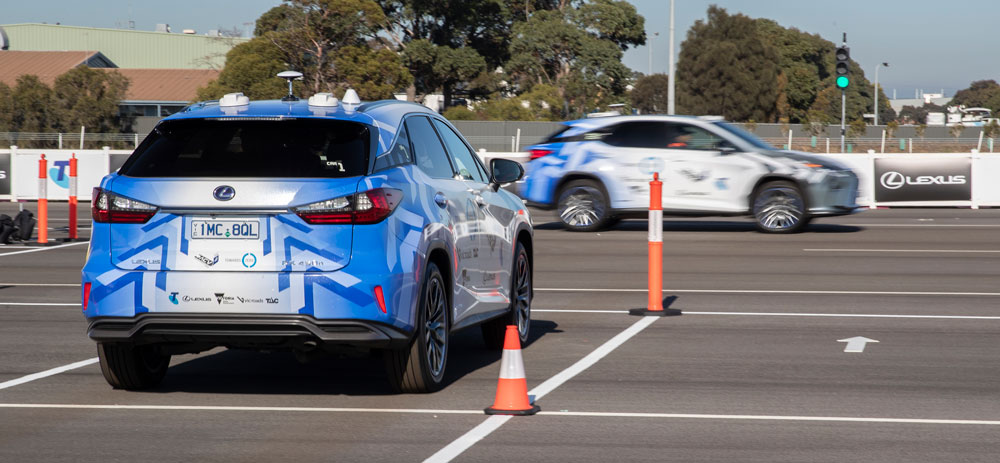ACV2 (Advanced Connected Vehicles Victoria)

The Advanced Connected Vehicles Victoria (ACV2) trial is a partnership between the Victorian Department of Transport, Telstra, Lexus Australia and the Transport Accident Commission. This trial developed and tested a connected vehicle system using Cellular Vehicle-to-Everything (Cellular-V2X) technology to enable communication between vehicles and with a network hosted platform to improve safety.
The ACV2 system enabled safety warning messages to be delivered to vehicles with very low latency using the existing 4G network. This approach to connectivity gives the potential for wide-scale deployment without significant roadside infrastructure expenditure, which will be a large hurdle for adoption. It is anticipated that this technology solution could facilitate earlier realisation of vehicle connectivity and its potential safety benefits.
The trial successfully tested six road safety-oriented use cases that consider speed, intersections, Vulnerable Road Users (VRU) and rear-end crashes.
Start and end dates: September 2018 - March 2020
Lead organisation: Telstra and Lexus Australia
Location: Melbourne, Victoria
Additional organisations: Department of Transport (Victoria), Transport Accident Commission (TAC)
Project budget, funding sources, components or breakdown of cost: $3.5 million grant as part of the Towards Zero Road Safety CAV Trial grants program, co-funded in a 50:50 arrangement Vic Gov:Telstra/Lexus (total project budget ~$7 million)
Contact person: James Soo (Manager Safer Vehicles and Future Vehicle Technology, DoT Victoria)
Link to project website: ACV2 (Advanced Connected Vehicles Victoria)
Included technologies
- Vehicle connectivity: Standards-based interoperable C-ITS
- Vehicle connectivity: Mobile data network based
Project stages
- Demonstration or Proof of Concept
- Testing for specific performance
Included locations
- Urban high traffic / high speed roads
- Rural motorways and divided highways
- Rural main highways
Benefits directly sought by the project
- Increase knowledge and experience of the technology
- Commercial return - product / service development
Project scale
- Two vehicles equipped with C-V2X technology.
- Six road safety use cases tested.
- Off-road testing and on-road testing was conducted in both metropolitan Melbourne and regional Victoria.
Further details on included technologies
- The Celular-V2X system enables communication directly between the vehicles and also via the cloud over the Telstra 4G network.
- V2V communication was transmitted directly using the short-range PC5 protocol and also over the Telstra 4G network.
- The cloud platform was developed for the V2X functionality enabling vehicles to communicate over longer distances and also receive information from DoT ITS infrastructure such as traffic signal status and speed zone information, including variable speed signs.
Objectives
Develop a 'Cellular Vehicle to Everything (C-V2X)' system to determine the potential safety benefits of connected vehicles.
Research questions that the project aims to address
- Can cellular V2X communications technology prevent accidents and reduce road fatalities?
- What is required in order to advance the availability of these solutions and accelerate their implementation and commercialisation?
- What issues are there with these technologies and what input should be provided into standards making?
Lessons learned to inform the conduct of trials
- Effective project governance and monitoring: regular formal meetings help keep project on track. There was good interaction between Industry and Government because the deliverables (expenditure breakdown, risks, promotional opportunities, access to data, schedule tracking etc.) and expectations were clearly defined and it helped keep the project on schedule. It is also important to regularly update senior management about project progress to enable buy-in if any risks or opportunities arise from the project.
- Share Lessons Learned as they occur: The sharing of Lessons Learned on a progressive basis (rather than at the end of the program) helps keep customers/partners aware of the major effort and breakthrough required to affect countermeasures, to highlight the IP creation and impact timing and cost.
- Promotion: Use every opportunity to help promote the technology.
- Workstreams: Find logical ways to maximise the expertise available across multiple deliverables and meet at least once a week whilst the development load is high. Have a governance structure for arbitration of different approaches and schedule management.
- Standardisation, security, interoperability, infrastructure availability (real and virtual) will be keys to success and need a national approach.
Lessons learned that inform future technology deployments
- C-ITS messages can be efficiently delivered to vehicles with low latency over the cellular network through priority of V2X services on Telstra 4GX mobile network.
- Virtual Road Side Units can be used to distribute infrastructure information to vehicles (traffic light timing and speed zones) at orders of magnitude lower costs than deploying physical road side units over a comparable area.
- Road Agency ITS information can be successfully integrated into cloud-based systems.
- Red light violation warnings could be generated early enough to prevent many avoidable crashes at intersections.
- Emergency brake light warnings shown to provide early alert even when the view is obstructed by other vehicles.
- "Positioning" is a key determinant of success in C-ITS because there is a high expectation for some use cases where lane-level accuracy is critical.
- High Definition Mapping to a recent datum is essential to prevent misoperation of use cases where a turning lane or slip road could confuse a use case.
- Dynamic speed zone information matches the actual road conditions, improving safety and reducing infringements.
Link to any other supporting project reports
Last updated: May 2021.
